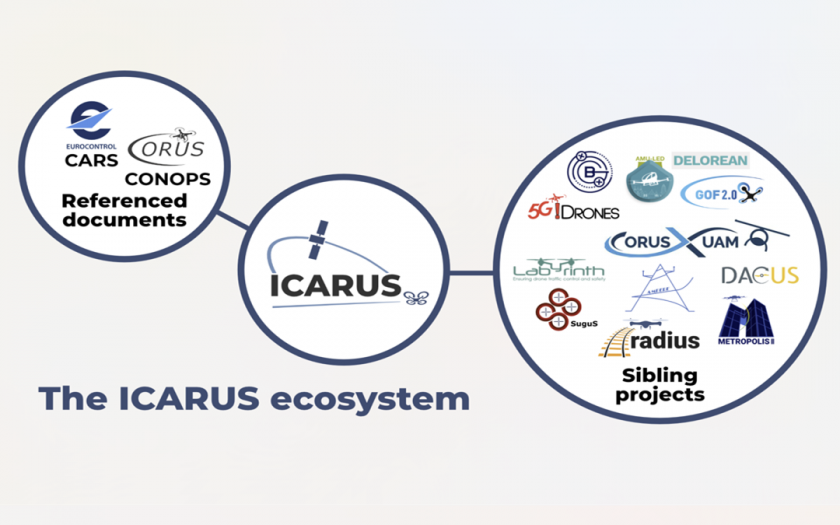Researchers from the European Union (EU) funded Integrated Common Altitude Reference system for U–space (ICARUS) programme have given an update on their work to identify related research areas in parallel programmes to exploit synergies and avoid duplication.
According to the programme’s website, the ICARUS project proposes an innovative solution to the challenge of a Common Altitude Reference System for drones inside very low level (VLL) airspace, with a global navigation satellite system (GNSS) altimetry-based approach – and the definition of a geodetic-barometric transformation algorithm, implemented by a dedicated U-space service. “ICARUS proposes the use of GNSS receivers with suitable requirements for a common vertical UAS-UAS reference and the definition of a new U-space service (U3) for altitude conversions in a common UAS-Manned aircraft reference, tightly coupled with the interface of the existing U-space services (e.g. Tracking, and Flight Planning services).”
Research work in related areas is taking place within other EU-funded U-space research programmes (see table below).
| Project name | Relation to ICARUS |
| 5G!drones | Could potentially provide 5G mobile networks as a service enabler for UAS and various supplementary services, among them for CARS. |
| Ampere | Added value of MCDF Galileo Receiver installed on drones for BVLOS operations, Ground obstacle and Terrain Model awareness |
| AMU-LED | AMU-LED will perform Urban Air Mobility demonstrations that constitute clear use cases for the ICARUS services. |
| BUBBLES | BUBBLES could potentially integrate the ICARUS services in their algorithms to improve their separation minima criteria. |
| CARS | The CARS document constitutes a foundation basis for ICARUS. |
| CORUS | The CORUS CONOPS is being used by ICARUS, especially with respect to VLL airspace classification and U-space service classification. |
| CORUS-XUAM | CORUS-XUAM is an VLD (Very Large Demonstration) SESAR JU Project. CORUS-XUAM demonstrations can help to validate the ICARUS concept. |
| DACUS | The ICARUS U-space service will be an essential element in providing safe separation and ensuring that such separation does not compromise avoidance of obstacles on the ground. |
| DELOREAN | Validation report in the urban environment about the performance of EGNSS receivers in presence of strong multipath, scattering or interference. |
| LABYRINTH | LABYRINTH will manage drone swarms. ICARUS would be very useful in ensuring vertical separation of these drones. |
| METROPOLIS | Integration of ICARUS into their validation demonstration would be mutually beneficial. |
| GOF2.0 | GOF20 is an VLD (Very Large Demonstration) SESAR JU Project. GOF2.0 flights can be used as a testbed for the ICARUS concept. |
| RADIUS | RADIUS will investigate an EGNSS-based augmented positioning system to navigate in a complex railway environment, providing useful information about the EGNOS Open Service capabilities and performance. |
| SUGUS | SUGUS is implementing an API for EGNSS services which could be used by the ICARUS services. |
To ensure workstreams are coordinated in the research work, the ICARUS team has developed a process of “cross-fertilisation” of project management.
According to a March 11, 2022, press release:
““The clearest benefit of cross-fertilization is the identification of redundant areas of research that are being actively pursued by other projects, thus ensuring the most effective use of resources is allocated, reducing wasteful duplication of efforts as much as possible. The main benefits can be summarized as follow:
To achieve these benefits, the methodology shown in the figure below is being used:

“The first step is to identify which projects are more interesting to our study in terms of the four potential benefits described in the previous section. In the case of projects that have already finished it will not be possible to influence them to consider or incorporate our research (thus the validation and cross-promotion benefits are not possible) but they have the advantage that their findings are published and can be analysed to be considered as input by ICARUS.
“In the case of concurrent projects, their objectives and proposed methodologies can be analysed to identify the most promising synergies that can be obtained through cooperating with them.
“Once these synergies have been determined, it will be possible to establish appropriate links with them for interchanging information. The process of discovery of potentially useful projects should be maintained during the whole lifetime of the project as new projects can be started after the initial analysis.”
For more information
Reaching better research outcomes using the cross-fertilization




